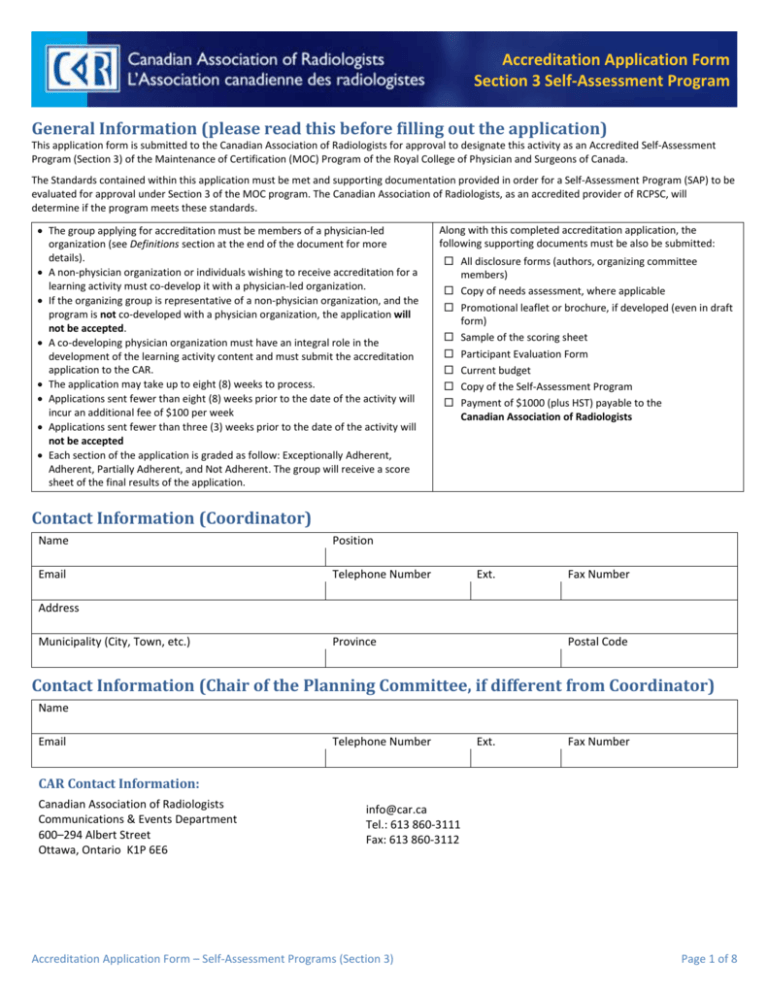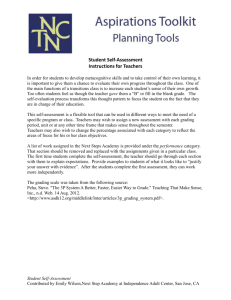SAP Accreditation Application Form
advertisement

Accreditation Application Form Section 3 Self-Assessment Program General Information (please read this before filling out the application) This application form is submitted to the Canadian Association of Radiologists for approval to designate this activity as an Accredited Self-Assessment Program (Section 3) of the Maintenance of Certification (MOC) Program of the Royal College of Physician and Surgeons of Canada. The Standards contained within this application must be met and supporting documentation provided in order for a Self-Assessment Program (SAP) to be evaluated for approval under Section 3 of the MOC program. The Canadian Association of Radiologists, as an accredited provider of RCPSC, will determine if the program meets these standards. The group applying for accreditation must be members of a physician-led organization (see Definitions section at the end of the document for more details). A non-physician organization or individuals wishing to receive accreditation for a learning activity must co-develop it with a physician-led organization. If the organizing group is representative of a non-physician organization, and the program is not co-developed with a physician organization, the application will not be accepted. A co-developing physician organization must have an integral role in the development of the learning activity content and must submit the accreditation application to the CAR. The application may take up to eight (8) weeks to process. Applications sent fewer than eight (8) weeks prior to the date of the activity will incur an additional fee of $100 per week Applications sent fewer than three (3) weeks prior to the date of the activity will not be accepted Each section of the application is graded as follow: Exceptionally Adherent, Adherent, Partially Adherent, and Not Adherent. The group will receive a score sheet of the final results of the application. Along with this completed accreditation application, the following supporting documents must be also be submitted: All disclosure forms (authors, organizing committee members) Copy of needs assessment, where applicable Promotional leaflet or brochure, if developed (even in draft form) Sample of the scoring sheet Participant Evaluation Form Current budget Copy of the Self-Assessment Program Payment of $1000 (plus HST) payable to the Canadian Association of Radiologists Contact Information (Coordinator) Name Position Email Telephone Number Ext. Fax Number Address Municipality (City, Town, etc.) Province Postal Code Contact Information (Chair of the Planning Committee, if different from Coordinator) Name Email Telephone Number Ext. Fax Number CAR Contact Information: Canadian Association of Radiologists Communications & Events Department 600–294 Albert Street Ottawa, Ontario K1P 6E6 info@car.ca Tel.: 613 860-3111 Fax: 613 860-3112 Accreditation Application Form – Self-Assessment Programs (Section 3) Page 1 of 8 Canadian Association of Radiologists Part A Organizational Information Name of the developing organization applying for accreditation Title of the Self-Assessment Program Online access to the Program Organization’s Website Self-Assessment Programs approved under Section 3 must be developed or co-developed by a planning committee consisting of members of a physician organization (See Definitions at the end of the document for more details). Please select the option that applies to your organization. Option 1 The planning committee consists of members of a physician organization that developed this Self-Assessment Program independently or in conjunction with another physician organization. Option 2 The Planning committee consists of members of a physician organization that prospectively developed this Self-Assessment Program in conjunction with another non-physician organization. We accept responsibility for the entire program. Option 3 This is an Accreditation Council for Continuing Medical Education (ACCME) accredited activity where the program was developed or co-developed by a physician organization (See Definitions at the end of the document for more details). Date the Program was completed DD/MM/YYYY Has the Program been previously accredited? Yes No If yes, by whom? How often is the program content and format reviewed? When did the last review of this SAP’s content and format take place? DD/MM/YYYY The number of hours required to complete the program is ________ hours Part B Audience and Planning Committee Indicate, from the options below, the target audience(s) for whom this Self-Assessment was created: Radiologists Medical Radiation Technologists Residents/Fellows Administrators Family physicians Other specialists (specify) Other healthcare professionals (specify) Clarification, if needed List all members of the SAP development committee, including their medical specialty or health profession, their affiliation and whether or not the latter is a physician or non physician organization. These committee members must be representative of the target audience listed above. At least one committee member for each of the above identified target audience must be listed below. Each planning/organizing committee member is to sign a disclosure form and copies are to be submitted to CAR with this application. Name Title Affiliation Representative of which Physician or Non-Physician target audience Organization Example: Dr. John Smith Staff Radiologist University of ABC Radiologists Physician Organization 1. 2. 3. 4. Accreditation Application Form – Self-Assessment Programs (Section 3) Page 2 of 8 Canadian Association of Radiologists Part C Needs Assessment Self-Assessment Programs provide participants with a strategy to assess their knowledge, skills, clinical judgement and attitudes in comparison to established evidence. All Self-Assessment Programs must use methods that enable participants to demonstrate these abilities across the key areas of the subject area, topic or problem. Please describe the key knowledge areas or themes assessed by this Self-Assessment Program: In order to develop this program, the group is to have identified a lack of knowledge or a need for improvement within an area. Indicate the assessment methods used to plan this Self-Assessment Program and to help determine its content (it is mandatory to have at least one of the following options identified): Perceived needs: Membership Survey Experts opinion Literature Guidelines Other (specify) Optional – Unperceived needs (please refer to Definitions at the end of the document for more details) Results from Self-Assessment Modules CMPA Regulatory authorities Experts opinion Practice audit results National or regional data bank Literature/research Pre- and post-tests of similar events Other specialists (specify) Please list the scientific evidence base (e.g., name which clinical practice guideline(s) and/or meta-analysis and/or systematic review, etc.) used to develop the content of this Self-Assessment Program and include details of where these references can be found. The evidence base must be directly related to the topic(s) covered in the course or activity. Please describe the rationale for the selected format (ex.: multiple-choice questions (MCQ), short answer questions (SAQ) or true/false statements) to enable participants to review their current knowledge or skills in relation to current scientific evidence. Part D Learning Objectives In order to ensure the objectives are properly composed from the perspective of the learner and not the instructor, we suggest you consult the « Creating and Writing Learning Objectives » document. Please avoid using verbs such as: understand, learn, know, believe, and appreciate. If the learning objectives submitted do not adhere to the format criteria or clearly state the goals, the application will be returned for revision and will not progress until this has been rectified. List the learning objectives of this Self-Assessment Program After completing this Self-Assessment Program, the participant should be able to/ After participating in this educational activity, learners will: 1. 2. 3. 4. 5. 6. The program’s learning objectives are to be communicated to the participants. How is this handled in this program? Accreditation Application Form – Self-Assessment Programs (Section 3) Page 3 of 8 Canadian Association of Radiologists Part E Evaluation of Participant Learning Providing specific feedback on which answers were correct and incorrect, with references, enables specialists to determine if there are important aspects of their knowledge, skills clinical judgement or attitudes that need to be addressed through engaging in further learning activities. Please describe the process by which participants will provide answers to individual questions. (e.g., through the creation of an answer sheet and scoring key, web-based assessment tools, etc.). Also provide a copy of the answer sheet or assessment tool with this application. Describe how participants will receive feedback on the answers they provided. Will participants be able to know which answers were answered correctly and incorrectly? Yes No Does the program provide participants with references justifying the appropriate answer? Yes No If yes, describe how the references are provided to participants How do participants receive feedback on their performance once the program is completed? Reflective Tool Does this program include a reflective tool that provides participants with an opportunity to document? (If so, please attach a sample.) Knowledge or skills that are up to date or consistent with current evidence? Yes No Any deficiencies or opportunities participants identify for further learning? Yes No What learning strategies will be pursued to address these deficiencies? and Yes No An action plan or commitment to change in order to address any anticipated barriers? Yes No Optional – Indicate if any methods are used to evaluate a participant’s integration of the newly-learned SAP content once back in workplace practice setting Post-test Exam Quiz Outcomes measurement (please explain) Other (specify) Assessment of Self-Assessment Program by Participant Does the program provide participants with an evaluation form that assesses (provide a copy of the participant evaluation form): Whether the stated learning objectives were achieved? Yes No Relevance of this SAP to the participant’s practice? Yes No The thoroughness of the content reviewed? Yes No The ability of the program to assess knowledge? Yes No Accreditation Application Form – Self-Assessment Programs (Section 3) Page 4 of 8 Canadian Association of Radiologists The ability to identify CanMEDS competencies or roles? Yes No The identification of bias? Yes No Does the program direct participants to document their learning in MAINPORT? Yes No Optional – As a result of the evaluation process for the program, will there be development towards improved healthcare outcomes? Yes No If yes, please describe: Part F Evaluation Form Provide a copy of the evaluation forms the participants of this event will be completing. Ensure these include the following components: Learning objectives for the overall event, which are to be listed and assessed Learning objectives for each session, including interactive segments, to be listed and assessed Bias, ethical conduct are assessed for the entire event and for each session Assessment as to whether there was enough interaction time All educational activities are to be assessed Interactive segments are to be assessed Impact on outcome of the learning objectives are to be assessed Evaluation forms are to be anonymous Promotional Leaflet or Brochure Provide a copy of this activity’s promotional leaflet or brochure, where applicable. These will be evaluated to ensure they respect the criteria established by the Royal College of Physicians and Surgeons of Canada, as well as the Canadian Medical Association Policy Guidelines (http://policybase.cma.ca/dbtw-wpd/Policypdf/PD08-01.pdf). Promotional leaflets or brochures for accredited Self-Assessment Programs are to: Have learning objectives for the SAP Identify the needs assessment used for the event program development Identify the target audience Also, If funding sources (sponsors) are identified in the leaflet or brochure as having provided educational grants, logos are not to be on the cover/first page If funding sources are identified in any other way in the leaflet or brochure, only company identification is permitted (no product specification) Accreditation Application Form – Self-Assessment Programs (Section 3) Page 5 of 8 Canadian Association of Radiologists Ethical Considerations All accredited Self-Assessment Program (SAP) must meet the ethical standards established for all learning activities included within the Maintenance of Certification program of the Royal College of Physicians and Surgeons of Canada. Include a copy of the current budget for this SAP, which identifies the sources of revenue as well as the anticipated expenses for the development of this SAP. The budget of this SAP is to be sufficiently autonomous without external funding. Activities approved under RCPSC Section 3 Maintenance of Certification Program must meet the CMA Guidelines (http://policybase.cma.ca/dbtw-wpd/Policypdf/PD08-01.pdf) governing the relationship between physicians and the pharmaceutical industry/equipment vendors. The planning committee was in complete control over the selection of the subject or topic and authors recruited to develop this SAP. Our program complies with this stipulation: Yes No The planning committee assumed the responsibility for ensuring the scientific validity and objective for the content for this SAP. Our program complies with this stipulation: Yes No Yes The planning committee includes a representative from the industry No If yes, what is this member’s role? The planning committee and authors will disclose to participants all financial affiliations with any commercial organization(s) regardless of their connection to the subject or topic of the SAP. Our program complies with this stipulation: Yes No If yes, how is this communicated to the participants? All funds received in support of the development of this SAP were provided in the form of an educational grant. Our program complies with this stipulation: Yes No N/A No drug or product advertisements appear on any of the SAP materials. Our program complies with this stipulation: Yes No Trade names drugs (where applicable) are used consistently and fairly throughout the SAP materials. Our program complies with this stipulation: Yes No N/A Identify all commercial organizations or other organizations funding this activity: 1. 2. 3. 4. If there are additional sources of financial assistance that have not been addressed here, please describe. Accreditation Application Form – Self-Assessment Programs (Section 3) Page 6 of 8 Canadian Association of Radiologists Part G Has this Self-Assessment Program been, or will it be, submitted to any other group for accreditation consideration? If so, please name the accrediting agent. The CAR will need to be advised of the results. Declaration I accept the responsibility for the accuracy of the information provided in response to the questions listed on this form and, to the best of my knowledge, certify that the guidelines quoted above have been met in preparing for this Self-Assessment Program. Name of the Chair of the SAP Development Committee (in print) Signature of the Chair of the SAP Development Committee Accreditation Application Form – Self-Assessment Programs (Section 3) Date Page 7 of 8 Canadian Association of Radiologists Definitions Physician Organization Non-physician or non-medical organization A not-for-profit group of health professionals with a formal governance structure, accountable to and serving, among others, its specialist physician members through: Types of organizations that are not considered physician organizations: Continuing professional development Provision of healthcare; and/or Research This definition includes (but is not exclusive to) the following groups: Faculties of medicine Hospital departments or divisions Medical (specialty) societies Medical associations Medical academies Physician research organizations Health authorities not linked to government agencies Disease-orientated patient advocacy organizations (e.g., Canadian Diabetes Association) Government departments or agencies (e.g., Health Canada, Public Health Agency of Canada) Industry (e.g., pharmaceutical companies, medical device companies, etc.) Medical education or communications (MEC) companies (e.g., CME inc.) For-profit online educators, publishing companies or simulation companies (e.g., Medscape, CAE) Small number of physicians working together to develop educational programming Perceived Needs Unperceived Needs Educational need that participants are aware they need to address. Educational needs that participants are unaware that they need to address The identification of perceived needs will assist in determining what educational interventions are needed. This will affect both the content and the most appropriate learning format to present the content. Perceived needs can be identified through the following: The identification of unperceived needs will assist in determining what educational interventions are needed. This will affect both the content and the most appropriate learning format to present the content. Unperceived needs can be identified through the following: Planning committee members personal experience, expert knowledge Surveys Questionnaires Focus groups Requests from the target audience Self-assessment tests Chart audits Chart stimulated recall interviews Direct observation of practice performance Quality assurance data from hospitals, regions Standardized patients Provincial databases Incident reports Published literature (random controlled trials, cohort studies) Educational Grant Funding or in-kind support provided by a commercial or other group towards an activity or educational program, which will be used towards the general organizing and presentation of the modules. Note: Commercial groups providing financial support to accredited CPD program cannot have any role or influence over any aspect of the CPD content or planning process. Funds gathered are not to be designated for a specific purpose (e.g., all funds are to be pooled in one budget where expenses for administrative support, planning group meetings and meals, development testing costs, etc. are assigned). A sponsor cannot cover the cost of an organizing group member’s travel expenses. Those costs could, however, be covered by the program’s overall budget. Physician organizations receiving "educational grants" should provide a statement of account to each sponsoring company for how funding was allocated or spent during the event. Accreditation Application Form – Self-Assessment Programs (Section 3) Page 8 of 8







